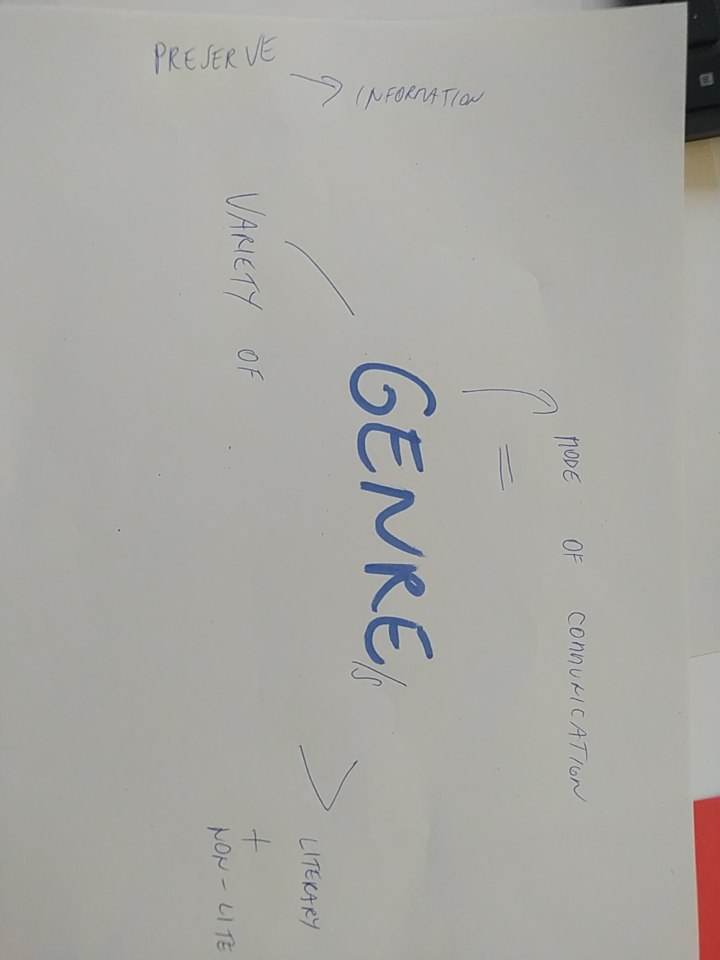Week 2 - reading: purpose statement, cohesion, abstract
Text 1 + Task 1 - identify key terms in the text and visualize how they are related (mind map, word cloud)
Humans and human societies have always organized and transmitted knowledge, meaning, and human experience by means of particular modes of communication. Oral cultures and societies preserve their knowledge using songs, stories, genealogies, poetry, hymns, and so on.Literate cultures preserve their knowledge using, among other things,lists, e-mail, recipes, newspapers, novels, maps, journals, books, diaries,textbooks, letters, and Weblogs. Such forms of communication are an inherent part of the organization of any culture because they structure and sustain society’s institutionalized means and modes of communication. The concept that covers this variety of forms of communication and human activity can be termed genre. Most people would probably instinctively associate genre with literary forms, such as the novel, the poem, or the drama, and there is nothing wrong with this. However, we also recognize that there are a number of communication forms pertaining to nonfictional prose and used in a variety of human activities.Genres of nonfictional prose cover the relationship between forms of communication, human activity and social organization, and how activities are typified by means of genre. Genre is thus broader than literary works. It follows that in order to understand genre we will have to look at more than mere text types. This chapter deals with genres of nonfictional prose. Although research in library and information studies (LIS)is not limited to nonfictional prose and its use in various professional or everyday life contexts, many classical LIS studies of, for instance, information use, are indeed studies of the use of nonfictional prose, in particular, scholarly literature. However, these studies seldom address textual form.
Task 1b - check your visual material, does it include some verbs and adjectives too? e.g. to preserve information / knowledge
Task 2 - predict, what is going to be the next sentence? Write it down:
Text 2 - task 2b: identify the purpose statement
The purpose of this chapter is to critically review, discuss, and analyze the concept of genre within LIS. This results in the following chapter structure. First, a discussion of the LIS context and its relation to genre is provided. Emphasis is on the significance of genre for LIS, why should want to know (more) about it, and what exactly it is about genre that is important for LIS to know. This is followed by an overview of genre and genre-related research in LIS and its implications for LIS research and discourse. I examine the ways genre theory has been employed in LIS research and related fields. Third, a review of genre theory research is provided in order to show what scholarly traditions inform modern genre theory and its concepts. Fourth, I outline basic concepts from genre theory in order to demonstrate their usefulness inLIS research. The concluding section points to the need for further genre-oriented perspectives in LIS research.
Task 2c: In the text above, find examples of:
passive voice
author´s voice
cohesive tools
linking words
It would tell us what kinds of genres various people and institutions in different communicative contexts prefer. A genre view of these communicative activities would provide a means to examine systematically document production and use and the organization of document production and use.
Thus, using genre as an analytical concept in LIS would help us understand how professional, cultural, and social communication is carried out. It would also enable understanding of how genres organize activity, texts, knowledge, and people.
This implies that we should view information systems not as ends in themselves but rather as means to an end. We should focus on what information systems do, as tools to be used in goal-directed activity.
For the sake of the argument, assume that LIS is the study of how and with what means professional, scholarly, cultural, and social knowledge as materialized in documents (print or electronic) is communicated in society and what function libraries and other similar knowledge organizing institutions or activities have, or are supposed to have, in these communication processes. 1
Moreover, a genre perspective would not only focus on the people and the production and use of various documents, but also stress typical activities in which people are discursively engaged. From a genre point of view, then, document production and use are looked upon not as ends in themselves but in terms of how documents help people do their work (cf. Bazerman, 2004, p. 319).
If LIS, by means of theoretical and empirical studies, can gain a more thorough understanding of situated and typified document production and use, then we may also be able to have a more informed understanding of the ways in which information systems help, or fail to help, people do their work.
As LIS is interested in how knowledge in documents and other arti facts is organized, genre theory is a productive perspective. Studying genres would reveal how they and human activity are important organizing factors of communication and knowledge.
Professional, scholarly, cultural, and social communication as manifested in documents comprises a diversity of genres: work orders, newsletters, recipes, bibliographies, articles in literary-cultural journals, surveys, chronicles, technical reports, governmental reports, scholarly articles, book reviews, and soon.
- Such a view may have been present in LIS but formulated in other ways. However, what has been missing is the genre perspective.
